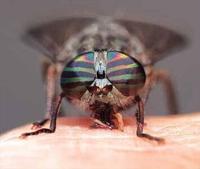Whoever created the phrase ‘once bitten, twice shy’ probably wasn’t talking about those pesky biting flies that follow you around at the cottage or campsite.
But if you’ve ever been bitten by a black fly, horse fly or deer fly, you don’t want to repeat the experience.
So what’s the difference between them?
Black flies
A photo of some black flies in search of a snack.
Canada is home to 161 species of black flies that have different life cycles, Algonquin Provincial Park says on its website. But at the park, only four species will bite humans, as the rest bite birds.
Black flies are small, about the size of a sesame seed, Bon Echo Provincial Park discovery guide Emma Fuller wrote in a blog.
It’s the female black flies who bite, as they require blood in order to develop eggs. They often land and crawl for some time before biting a thin skin area. They cut and rupture the skin, soaking up the blood. Irritation from the fly’s saliva can also cause swelling and itching in some people.
Most species of black flies come out from mid-May until late June, depending on the weather — and primarily during the day. They seem to be most abundant on hot, humid spring days, and can cluster in a swarm.
They are attracted by sources of carbon dioxide, body heat, and the smell of products that feature perfumes, including body wash, shampoo, skin lotion, and cologne.
They have a short lifespan — about three weeks.
Deer and horse flies

A horse fly acquiring blood for her eggs.
Horse flies are relatively large and darkly coloured, while deer flies are smaller and have colourful eyes and dark-patterned wings, Algonquin Provincial Park notes.
They typically show up after the peak black fly season — most abundant during the summer months of July and August, and fly only during the day. Being visual feeders attracted to motion, these insects circle humans waiting for a good time to land and obtain a meal.
But they also bite wildlife, hence their names.
Unlike a mosquito, these insects have biting mouth parts that occasionally feel like they are “taking a chunk of skin” as a meal.
Again, only the females bite during mating season, as they also need blood to produce eggs. Male horseflies only feed on flower nectar or pollen, and don’t have the mouth parts to bite.
Why do we have to put up with these biting flies?
These tiny bugs actually become a food source for fish, reptiles, amphibians, birds, and mammals.
The larva of biting insects, particularly mosquitoes, are eaten by aquatic wildlife. Adult flies feed many species of birds and bats.
And horse flies actually help pollinate plants, as the males feed on nectar and pollen.
Will they be bad this year?
The Weather Network actually keeps a weekly forecast on the biting insect season, with predictions that black fly and deer fly activity will remain low through the end of the month.
How can I prevent a bite?
For black flies, covering up with clothing, such as a bug jacket, and applying insect repellent as directed offers some deterrent to black flies.
For horse and deer flies, repellent seems to be less effective. Cover your head, arms, and legs with light clothing is a good way to deter the bites from these insects.
If camping, set up a dining tent, or add insect netting to your tent if you are able.
And bugs usually don’t like the scent of citronella candles. Light one at your picnic table to keep bugs off as you eat.
For more information on biting insects, visit algonquinpark.on.ca.





)






